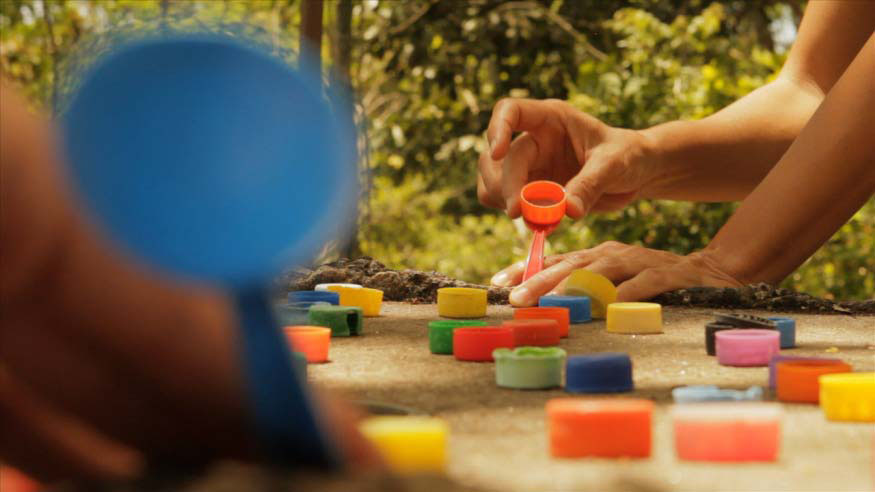
© » KADIST
Jonathan Hernández
In line with Hernández’s interest in catastrophe, Vulnerabilia (choques) is a collection of images of shipwrecks and Vulnerabilia (naufragios) collects scenes of car crashes. The artist has said that the appropriation of popular imagery is a way for him to take pictures without a camera and to register the things that happen in the everyday as visual essays that evidence the fragility of the world.

© » KADIST
Donna Conlon and Jonathan Harker
In Tapitapultas (2012), Donna Conlon and Jonathan Harker comment on mass consumerism and pollution by way of a game they invented. The artists used disposable spoons as catapults to shoot thousands of plastic bottle caps at a hole in a concrete platform. The platform was once part of a U. S. military installation in the Panama Canal Zone, and it is now an observation deck in a nature park.

© » KADIST
Jonathan Monk
Untitled (rolled up) , is an abstract portrait of Owen Monk, the artist’s father and features an aluminum ring of 56.6 cm in diameter measuring 1.77 cm in circumference, the size of his father. Jonathan Monk bridges a conceptual art and his family privacy, and ironically ensures that there is “no difference between Sol Lewitt and my mother, he does not know more than she do not know. ” What is the status of the O-backed chair rail to the white cube?

© » KADIST
Jonathan Monk
Drawing & Print (Drawing & Print)
Meeting #100 is one in a series of text works by Jonathan Monk. In this series, the artist attempts to organize meetings somewhere in the world. The audience is given the details of a meeting—the place, date and time—and nothing more.

© » KADIST
Nathan Lewis
Drawing & Print (Drawing & Print)
Nathan Lewis has always made figurative and abstract drawings, which are related to anatomical textures and patterns he encountered when working as an ICU nurse. Hence the title of this work, Tissue II , is a spare and elegant work, in which the artist combines hand sculpted paper with embossment and frottage for the first time in his practice. The effect recalls African weaving and skin embellishment, but also reflects the influence of his former job as an intensive-care nurse, seeking to heal the most damaged.

© » KADIST
Carlos Fernández
Part of the exhibition PIÑA MATRIZ (2014) at Despacio Art, this untitled work by Carlos Fernández is a wood panel (formerly a section of a wooden table top) that bears the residue of insects interacting with fermented pineapple. The exhibition considered the production of pineapple monocultures and the agricultural monopolies for this product. Fernández used the exhibition space to portray alternative possibilities of diversified and ecologically sustainable production that could be mobilized in place of mass produced pineapple monocultures.

© » KADIST
Ana Teresa Fernández
Drawing & Print (Drawing & Print)
The artist writes about her work Borrando la Frontera, a performance done at Tijuana/San Diego border: “I visually erased the train rails that serve as a divider between the US and Mexico. I painted them sky blue, creating a “Hole in the Wall” This deconstruction of “feminized” work explores the difficulties in reconciling both low wages and undervalued work via social and political infrastructures, confronting issues of labor and power. The images that I myself perform, present a duality: women dressed in a black tango dance attire while engaging in de-skilled domestic chores; the surreal within non-fiction.

© » KADIST
Miguel and Natalia Fernández de Castro and Mendoza
The Absolute Restoration of All Things is a collaboration by artist Miguel Fernández de Castro and anthropologist Natalia Mendoza. For this project, Fernández de Castro and Mendoza researched the 2014 court case that shut down Penmont Mining’s operations in the middle of the Sonoran desert. The lawsuit was brought to court by the “ejidatarios” (communal land holders) of El Bajío, Sonora, who claimed that their territory was illegally occupied and exploited, causing an irrevocable environmental impact on their land.
Jonathan Monk
- location: Berlin, Germany
- year born: 1969
- gender: male
- nationality: British
- home town: Leicester, United Kingdom
Nathan Mabry
- location: Los Angeles, California
- year born: 1978
- gender: male
- nationality: American
- home town: Durango, Colorado
Donna Conlon and Jonathan Harker
- location: Panama City, Panama
- year born: 1966
- nationality: American and Ecuadorian
Nathan Lewis
Nathan Lewis’s unfeigned drawings have evolved out of the nine years he worked as a critical care nurse at a Washington, D.C...
-
2000-2009
Jonathan Monk
2003Untitled (rolled up) , is an abstract portrait of Owen Monk, the artist’s father and features an aluminum ring of 56.6 cm in diameter measuring 1.77 cm in circumference, the size of his father...
Jonathan Hernández
2008In line with Hernández’s interest in catastrophe, Vulnerabilia (choques) is a collection of images of shipwrecks and Vulnerabilia (naufragios) collects scenes of car crashes...
-
2010-2019
Ana Teresa Fernández
Drawing & Print
2011(Drawing & Print) The artist writes about her work Borrando la Frontera, a performance done at Tijuana/San Diego border: “I visually erased the train rails that serve as a divider between the US and Mexico...
Donna Conlon and Jonathan Harker
2012In Tapitapultas (2012), Donna Conlon and Jonathan Harker comment on mass consumerism and pollution by way of a game they invented...
Carlos Fernández
2014Part of the exhibition PIÑA MATRIZ (2014) at Despacio Art, this untitled work by Carlos Fernández is a wood panel (formerly a section of a wooden table top) that bears the residue of insects interacting with fermented pineapple...
-
2020-2029
Nathan Lewis
Drawing & Print
2021(Drawing & Print) Nathan Lewis has always made figurative and abstract drawings, which are related to anatomical textures and patterns he encountered when working as an ICU nurse...
Miguel and Natalia Fernández de Castro and Mendoza
2022The Absolute Restoration of All Things is a collaboration by artist Miguel Fernández de Castro and anthropologist Natalia Mendoza...


